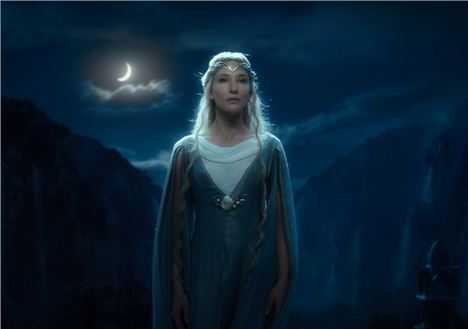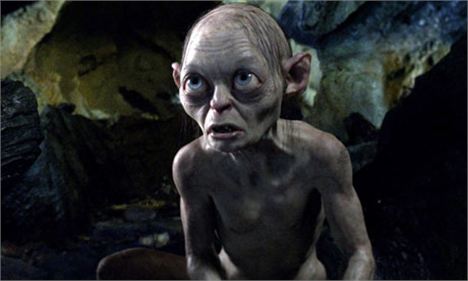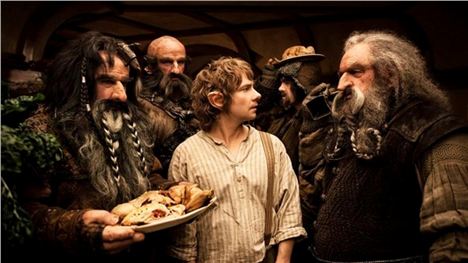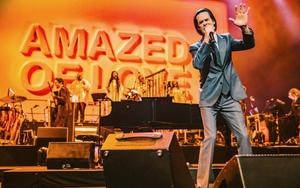AFTER the colossal success of his adaptation of Tolkien’s The Lord of the Rings trilogy, ten years on writer/director Peter Jackson has returned to Middle-earth (AKA New Zealand) to film the prequel in three parts. This might be an unexpected journey, but Jackson’s certainly decided to take the long way around.
On the one hand everything is eyeball-achingly detailed, on the other the characters move in slightly jerky, sped-up motions, like they’re all listening to The Benny Hill theme.
The film opens on the familiar faces of Ian Holm’s aged Bilbo and the curiously ageless Elijah Wood’s Frodo. It’s Holm’s genteel narration that takes us back 60 years to when he was Martin Freeman (Sherlock, The Office), and about to go on an adventure. The wizard Gandalf the Grey (Ian McKellen) turns up at Bilbo’s door unannounced and soon brings with him a company of 13 dwarves, largely distinguishable by their creative use of facial hair.
Led by the warrior Thorin Oakenshield (Richard Armitage, Spooks), the dwarves want the reluctant Bilbo to be their burglar on a quest to take their home and treasure back from the dragon Smaug. Unfortunately, their journey to the Lonely Mountain does not run smooth, an old enemy of Thorin’s is on their trail and the questers are beset by hungry mountain trolls, Warg-riding Orcs and tumorous goblins.
 I'm a good health in good elf - have I said that right
I'm a good health in good elf - have I said that right
The first thing you’ll notice about the return to Middle-earth is that everything is in sharp relief – and that isn’t just down to the 3D. Jackson’s filmed his trilogy at 48 frames per second, twice the normal speed. This takes some getting used to. On the one hand everything is eyeball-achingly detailed, on the other the characters move in slightly jerky, sped-up motions, like they’re all listening to The Benny Hill theme.
Any other special effects-laden film could bow under such close scrutiny; there’s no hiding any dodgy wigs and prosthetic noses when the audience can see into every pore on a dwarf’s face. However, the landscapes and people of Middle-earth can now be seen in all their exquisitely designed, awe-inspiring glory. The CGI has improved vastly since Jackson’s first foray into Tolkien’s literary world and the creatures that populate it are breathtakingly realised.
The choice to split Tolkien’s shorter work into three films has been criticised for stretching the material too thinly. It’s true that this has allowed for some overindulgence in scenes that would only usually see the light of day as DVD extras (the overlong opening may task the viewers who don’t care for harmonising dwarves). Still, the beauty of Tolkien’s work is in the details, and the script team are back on form.
Fran Walsh and Philippa Boyens co-write again with Jackson, and they’ve been tasked with producing a cohesive prequel from a book that is considerably lighter in tone than its sequels. Largely, they are successful. There are a few moments that delve into dwarfish slapstick, which doesn’t always sit easily within the gravity of the situation. Still, that’s a minor quibble. The team even keeps the script clangers to a minimum (although that’s largely thanks to a lack of Legolas in this installment).
High-fantasy viewing demands credible actors to make it work, and Jackson’s recruited them by the cart load. Freeman’s everyman, fish-out-of-water shtick, is ideal to portray Bilbo. In a world where 50% of the population is CGI, Freeman’s naturalistic bumbling gives the film its realistic grounding. McKellen’s subtle and quick-to-anger Gandalf is as enjoyable as ever and when the wizard finally breaks out the magic, it’s genuinely awesome.
It takes some talent to wear a fake nose and hair braids and still be taken seriously. Armitage is note-perfect as the world-weary Thorin and makes it easy to see why the character demands loyalty from his band of skirmishing dwarves.
Still, the standout performance was always going to be the scene-stealing Andy Serkis. His performance capture antics have once again rendered the computerised (but scintillatingly accomplished) Gollum as a heart-breaking, funny and vile character as real and complex as any one of his human counterparts.
One criticism would be that the characters aren’t as distinctive as the Rings fellowship; while the design team has obviously worked hard to distinguish each dwarf, inevitably only a few stand out. After Thorin, there’s the reliable James Nesbit’s Bofur, Aiden Turner’s Kili (this trilogy’s Legolas) and Dean O’Gorman’s Fili (The Almighty Johnsons). The rest are recognisable by their most obvious feature, be that girth, baldness or an axe in the head. Hopefully the rest of the trilogy will make up for this disappointing characterisation.
Despite fears of there being too much filler, the film doesn’t often let up in pace and there are battles aplenty that are suitably grisly. This might be another quest plot that plods similar ground to the Rings trilogy, but there is a surfeit of new perils and monstrous entities to encounter that will keep you entertained.
If you like your fantasy succinct, then the first (or indeed any) part of The Hobbit trilogy isn’t for you. You can accuse Jackson of overindulgence, but fans will find much to enjoy in getting the extended edition early.
Rating 8/10
Yes, I'm a confused hero
















